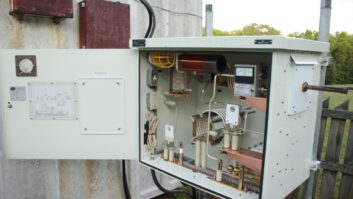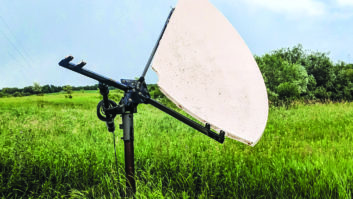As our thoughts turn to spring, let us remember our tiny winged friends and their desire to wreak havoc in our lives by building nests in the most unusual of spaces.
I’ll never forget unbolting an LNB only to be greeted by several wasps trying to squeeze their way past the gasket — there was a momentary stare-down, then my jump/fall off the ladder, and to safety. I hate bees!
You can avoid these problems by inspecting your dishes, tower bases and AM coupling units now, before the home-building begins. Use bee-spray liberally. Plug all holes, make sure all covers are secure. In this day and age, time at the transmitter site for maintenance is little more than a fleeting thought. Set aside a couple of hours, armed with spray and RTV — your diligence will pay off!
. . .
Our test for waterlogged STL antennas brought an interesting problem that ought to be on an SBE exam. See if you can figure this out.
A brand-new STL was engineered, using the computer models, with plenty of fade margin. This was a digital link, using a composite STL transmitter and receiver, with add-on digital encoders. Everything was new.
When the system was turned on, the digital encoders would not work — all the red lights came on, although there appeared to be some received signal on the composite receiver. The received signal was one-quarter of the amount predicted. Pulling the digital encoder/decoder and feeding a composite test signal out of an Optimod fed into the composite input yielded a lot of noise.
When the digital encoder/decoder was set up on the bench, back to back, without the STL, it worked fine. Plug it back into the STL transmitter and receiver, and nothing but red lights. There was no spectrum analyzer immediately available.
A call to the STL manufacturer was made and a second receiver was sent. The same problem occurred. Give the matter some thought, and read on for the answer!
. . .
We haven’t had a Workbench Rolodex item in awhile. This card from Famous Telephone Supply is a good addition to your list of “must-haves.” Add it to your resource list:
Famous Telephone Supply (800) 321-9122 807 East Turkeyfoot Lake Road P. O. Box 28577 Akron, OH 44319
These folks offer voice and data products, and hold a Fall Expo in Cleveland each year. In addition to the latest in fiber, network, T1 and Key system products displayed, they usually provide technical seminars.
If you maintain your station’s telephones or network systems, get to know these folks!
. . .
(click thumbnail)In the never-ending search for what to do with those computer keyboards, Lee Simmons, director of engineering for the Hilton Head, S.C., stations owned by Adventure Communications, came up with the idea shown in the picture below. The console cabinetry was designed with a recessed tray, in front of the audio console, which holds the three keyboards. When the keyboards are not needed, a hinged cover swings up from below, providing work space for logs, writing, etc.
Lee explains that because the operators usually use touchscreens or a mouse, the keyboards are not always needed. Rather than clutter up the studio, this hidden cover — sort of a reverse piano key cover — was used.

. . .
Well, did you come up with an answer to the STL problem?
If you suspected the transmitter, and thought it was off frequency, give yourself a pat on the back.
Turns out that the transmitter was slightly off frequency due to internal shipping damage. Without a frequency counter or analyzer, this couldn’t be immediately verified. Everything looked fine inside — the frequency jumpers were properly set.
The shift in frequency was not enough to prevent decoding some of the composite signal; it was, however, great enough to prevent any of the digital signal from being received.
A fun brain twister, now that the problem is solved. Not so fun for the engineer facing his owner, though!
Submissions for this column are encouraged, and qualify for SBE recertification credit. Fax your submission to (703) 323-8044, or e-mail to [email protected]










